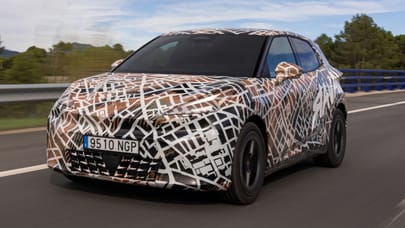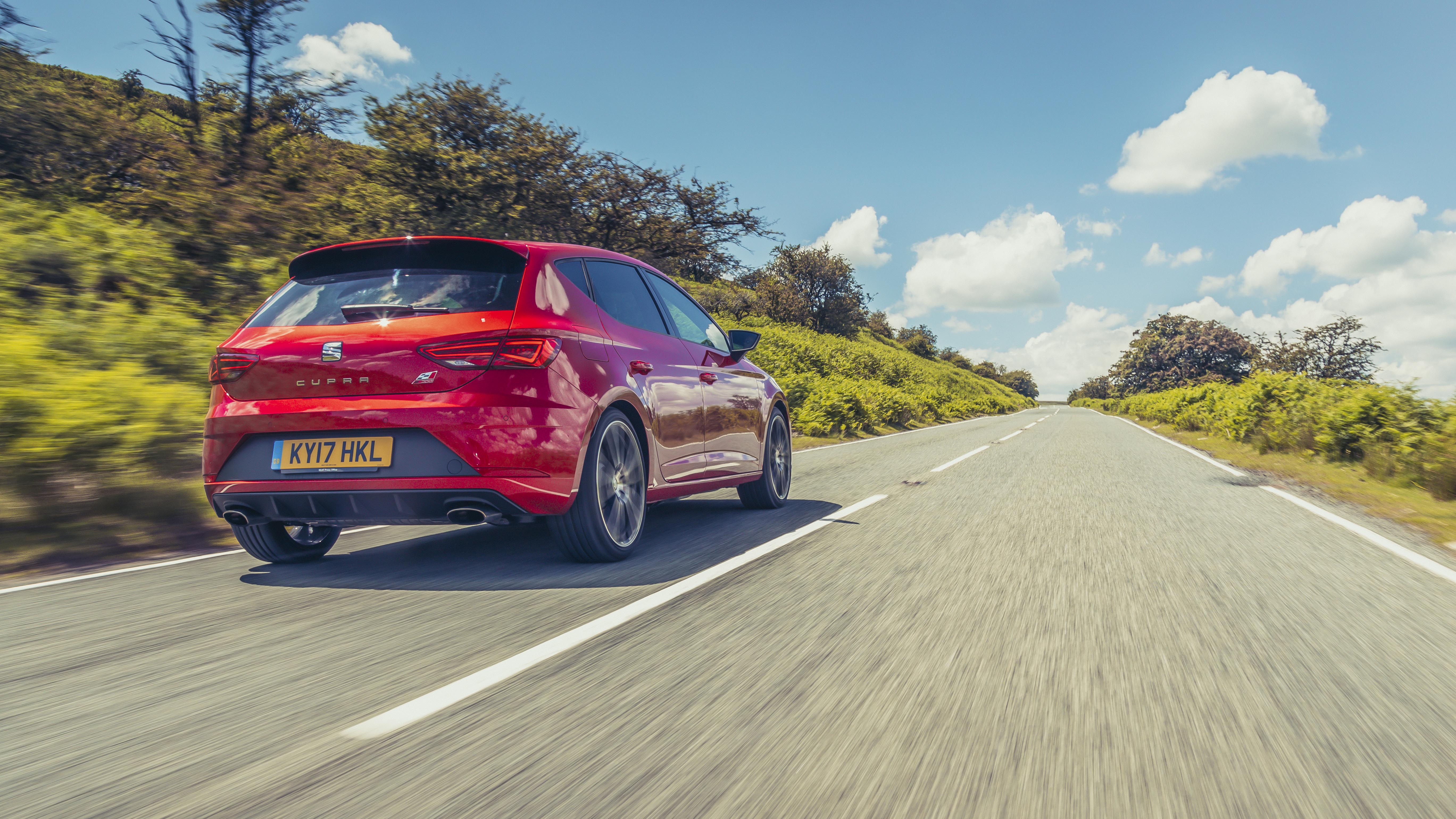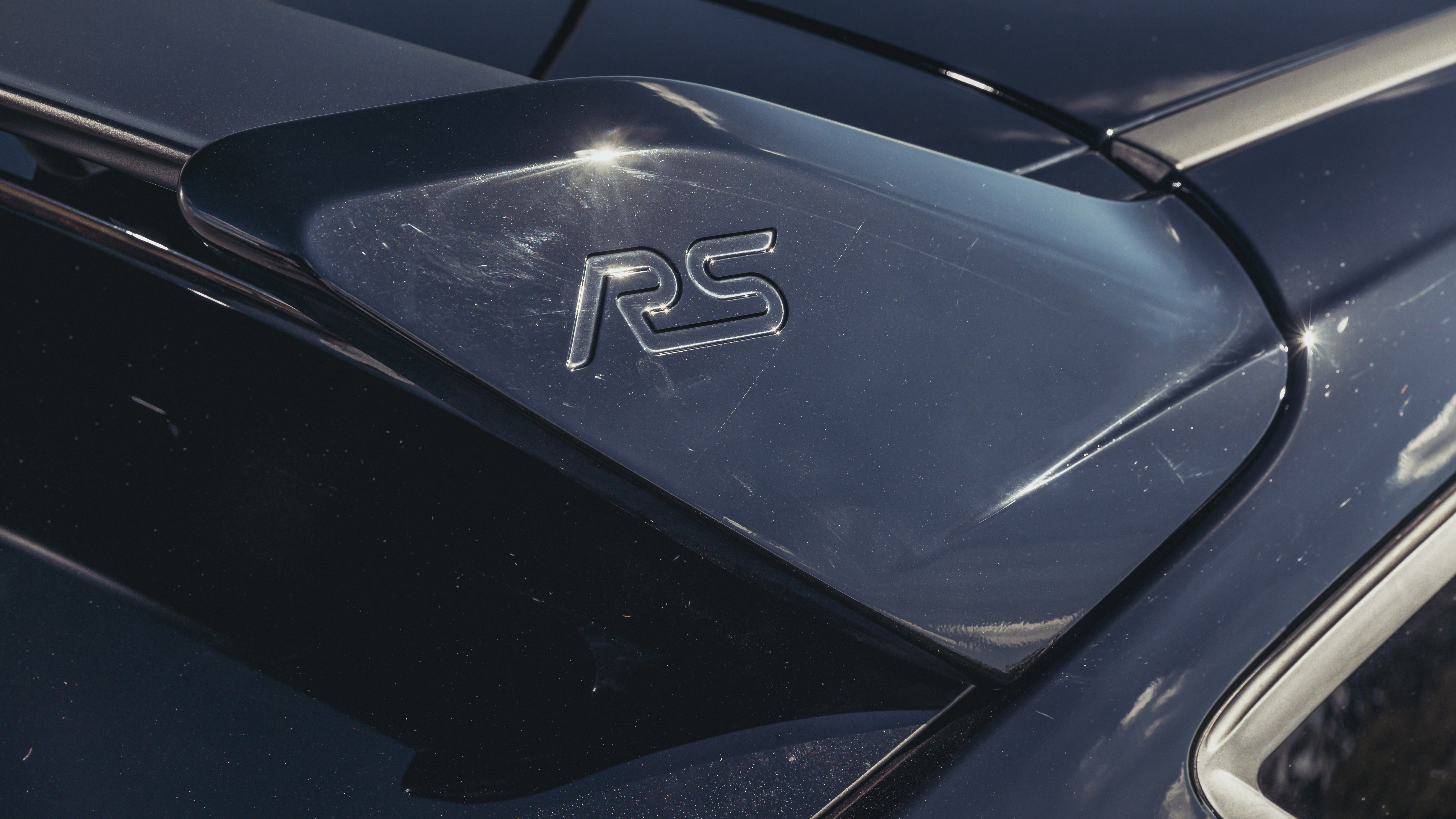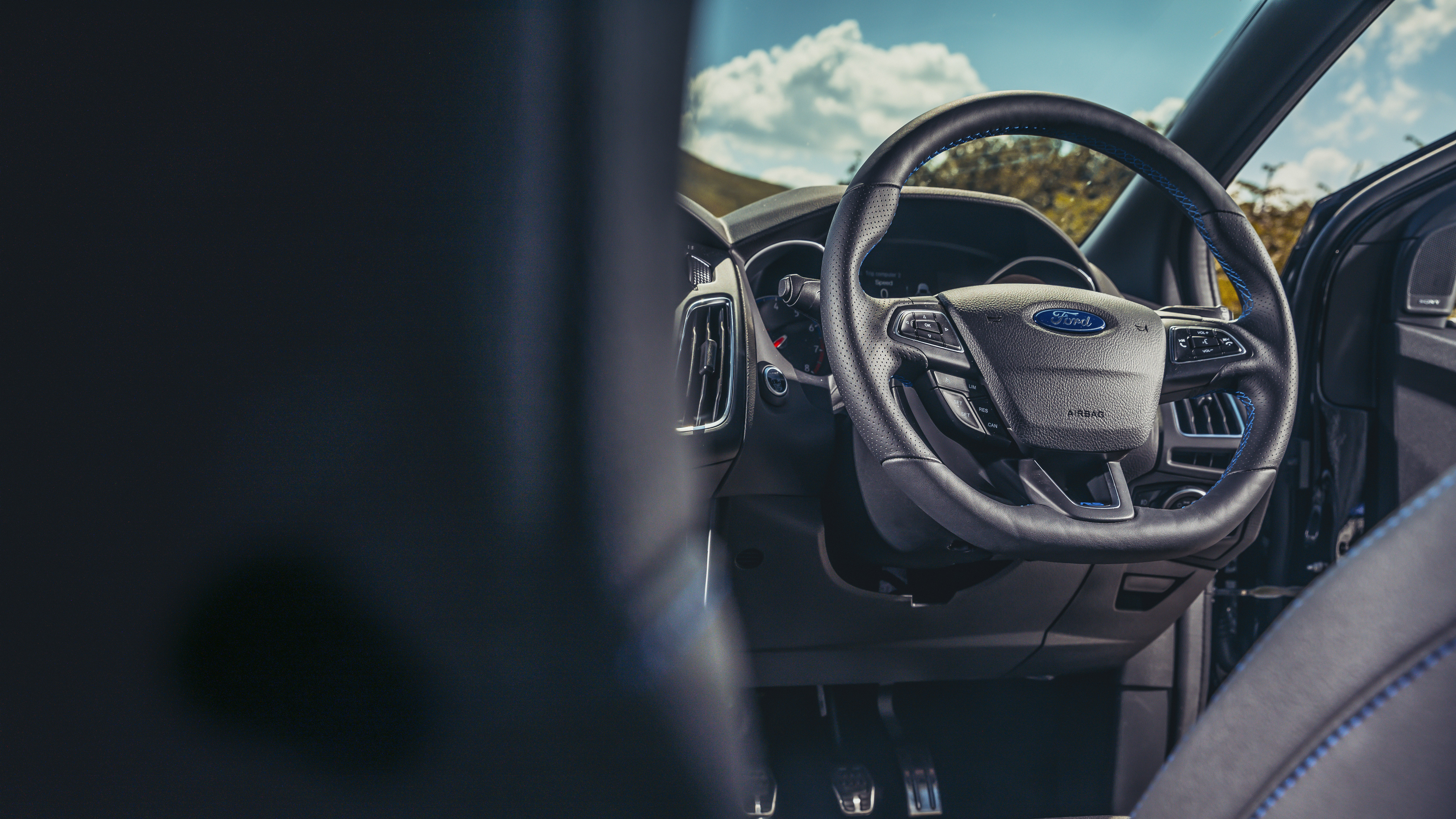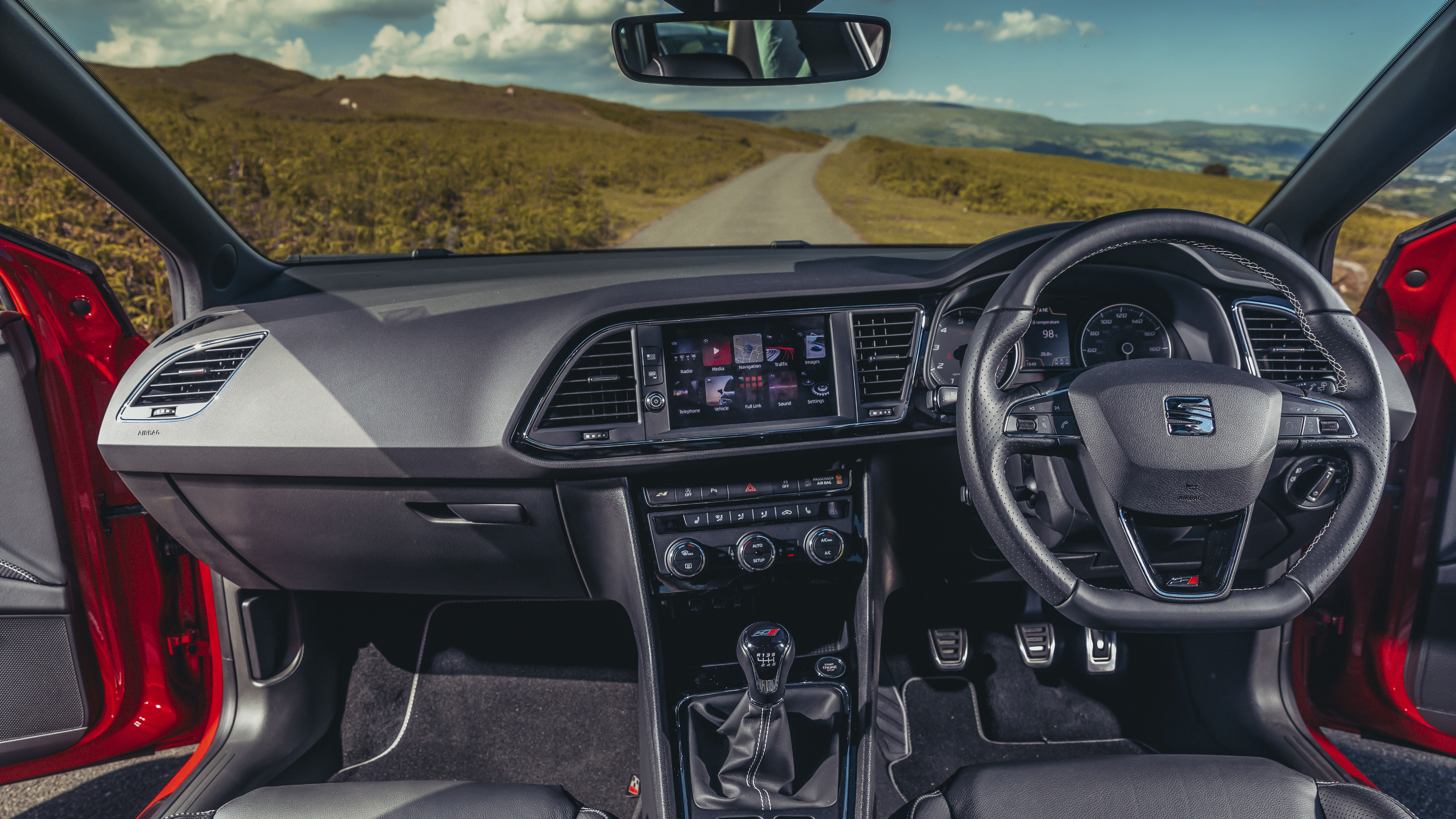
Honda Civic Type R vs Focus RS vs Golf R vs Leon Cupra
The new Type R meets the current hot hatch heroes: Leon Cupra, Focus RS and Golf R. Engage maximum attack
The hot-hatch experience is defined by third gear. The tricky dogleg throw across the gate has been dealt with, the weaving, tugging torque steer of second gear is no longer pulling you across the road and you’re now in the everything gear.
Third, in a modern turbo hatch, will not only take you beyond the legal speed limit on a British motorway, but also deliver enough oomph to snap through roundabouts if you can’t be arsed to snick back down through the dogleg to second.

Words: Ollie Marriage
Photography: Mark Riccioni
Most importantly, third is the B-road gear, the Wales gear. I’m not saying that others won’t be deployed, because there’s some cracking sweepers around here where fourth is the more natural choice, and a handful of tight hairpins that demand second if you’re to keep any momentum. But on the whole, yeah, third, that’s where it’s at.
We hear Stephen - who's in charge of bringing the Honda Civic Type R to us - coming. The Civic is clearly in third, the exhaust blare flat and breathy as it rises and falls with the road. We’re lounging with the reception committee, all of which seem relaxed and confident, happy to wait in the sunshine for the arrival of the main event.
None of them has met before. I know that sounds ridiculous when the Seat Leon Cupra and VW Golf R seem so commonplace, but we crowned the Ford Focus RS last spring and it’s now the oldest car here. Both the Golf and Leon have been updated in the last few months. They have more power, better software, sharper LED light signatures, enhanced safety systems and bigger infotainment screens. And, yes, I’m afraid to say that all that stuff matters. You might not care that the Leon now has wireless phone charging or Pedestrian Protection, but lots of people shelling out £30k on a new car do. In this sector, the hot hatch has grown up. And yes, I am alluding to the fact that image matters. More anon, when the Civic isn’t within earshot.
To manage its newly acquired 296bhp (a 10bhp rise) the Leon has an electronically controlled differential and DCC (Dynamic Chassis Control) as standard. The Golf R doesn’t get the latter unless you shell out £830. And you’ll have had to pay at least £1,545 more for the privilege of having a 4WD VW instead of a FWD Seat in the first place. And this Golf isn’t a base one; instead it’s in the most common configuration – five doors instead of three and fitted with the twin-clutch DSG gearbox. No DCC, though. £34,250 makes it the most expensive car here, a couple of grand beyond either the Civic Type R or Focus RS.
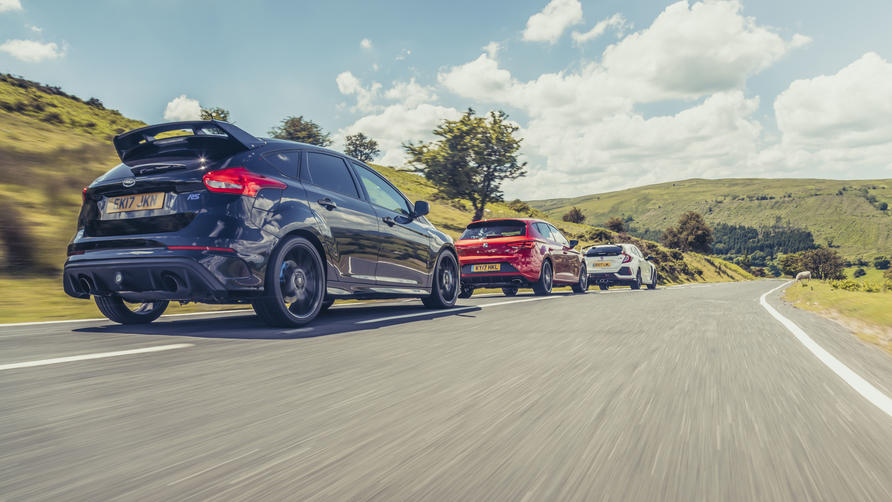
The Focus is the car we know and love, a 345bhp, £32,265 broad-shouldered charger. No one is fooled by the black-on-black attempt at stealth. This car is an extrovert. With a Drift mode. The Civic makes do with +R mode, a mechanical differential and a mere 316bhp. But it weighs 1,380kg to the burly Ford’s 1,547kg, so each kilo has greater force shoving it along. In GT trim with blind spot warnings, dual-zone climate and so on, it’s £32,995.
So here’s what we’ve got: the Golf, perhaps fittingly, is the only auto, the Focus is the only one with a swept volume over 2000cc, the Leon is the only car with less than 300bhp (just), the Golf is the only one without some form of adaptive suspension, the Focus is the only one with a conventional handbrake (hey, these are hot hatches – that might matter to you), the Leon and Civic are front-drivers, the others push power out through all four, the Civic is the only one on 20s, and they’re 10mm wider than the 235/35 R19s worn by all the others. Clear? I hope so, because I want to get on with driving.
Because here’s the sheer, unbridled truth: these hot hatches are a joy to drive. They’re the right size, the right power, configuration, grip and so on. I came into this test from driving a McLaren 720S, which was so fast you could only deploy max throttle for, well, it was quite exciting, so let’s say seven heartbeats. But you can extend a hot hatch, feel like you’re tickling the limits. You are its equal.
Point of housekeeping. Ignore the 0–62mph acceleration. It unfairly favours the 4WD cars. To help you out, we ran each car through the gears from 30mph to 70mph. The Focus was the slowest at 4.5 seconds – blame the hiccup of lag with each shift for that – but losing to the 49bhp less powerful Leon, even if only by 0.1secs, must’ve hurt. The Civic was two tenths further ahead and can claim the moral victory as the only reason the Golf beat it (with a time of 4.1secs) was due to its zero-shift double-clutch gearbox. Worth a handful of tenths.
Top Gear
Newsletter
Thank you for subscribing to our newsletter. Look out for your regular round-up of news, reviews and offers in your inbox.
Get all the latest news, reviews and exclusives, direct to your inbox.
So the Civic feels the fastest on the road, then? No, that honour goes to the only one with under 300bhp. Plain weird. But here’s why the Leon feels so fast: it can barely cope. The old Leon, with 280bhp, was sweet, but the extra power has soured the balance between chassis and engine.
Give it the beans in third (max torque from just 1,800rpm), and the pressure through the diff causes the steering to become slightly snatchy. Yep, torque steer, but of a very particular kind. It’s discomforting, a bit wild, but several people love the Leon all the more for it, because it gives the Seat a stronger, more accessible personality than the Golf.
You find it elsewhere, too. The engine note is cleaner, less pumped through the speakers, the throttle mapping in Cupra mode is ace, the engine always feeling urgent, and it’s more spritely and alert through corners. But I do wonder what it would be like on the 51 weeks a year when the UK isn’t basking in a heatwave. Think we’d be looking at a significant traction deficit.
But surely we could level the same criticism at the front-drive Civic, too? You could, but I don’t think the Civic will suffer to the same extent. It’s too competent, too professional for that. Because this thing is a front-wheel-drive masterpiece. The front axle is easily the most positive and precise of these four, the steering is the most together, the least distracted by bumps or throttle, so you can just get on with the business of turning and enjoying. The others, to a greater or lesser extent, suffer from heave and wallow, lift and roll.
The Civic’s centre of gravity is supercar low, its suspension movements minimal - no matter how hard I try, I can’t get it to lift a wheel in corners. Until I tip it off a verge. It whips through corners, the mechanical differential clawing traction, the suspension, well, it’s uncanny how it separates the precision and accuracy you want from the harshness and ricochet you don’t.
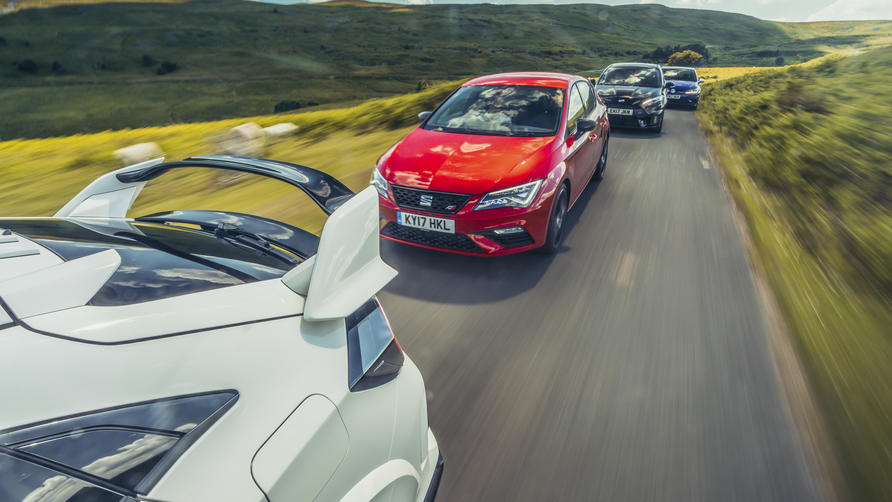
Body control is absolute, the steering is weighty and conveys clear messages about grip and surface, yet the ride is comparatively supple. It doesn’t buck and weave like the Focus, but gives you all the good stuff, with none of the heart-in-mouth moments. Expand this out to the car’s behaviour in any situation, and you realise that the single most staggering element of the new Type R is its bandwidth. Honda has somehow broadened the Civic’s repertoire at both ends – it’s scalpel-sharp yet an accomplished cruiser. That’s a very, very tough brief to nail.
It’s the one thing we used to say about the Golf R, too. But something has shifted here. Either VW, startled by the car’s success, has taken the decision with this midlife refresh to push it further into the luxo-hatch mainstream, or the absence of DCC narrows the R’s range.
I hope it’s the latter and that a tighter, flatter suspension mode might have breathed more life into the steering, more energy into the way it drives. As it is, it cruises brilliantly, traction is boundless, it’s nicely balanced and the engine is strong and responsive, but it doesn’t sparkle as brightly as I remember. Doesn’t feel as nimble and agile on these wonderful roads.
But both it and the Leon do shine an unflattering light on one element of the Civic’s performance. The VW Group’s 2.0-litre turbo is a zingy, responsive motor that picks up quickly and feels sharp under your foot. The Civic’s is stodgier. Blame the turbo. There’s more inertia to overcome, so it doesn’t spin up so fast and reacts more lazily to throttle inputs.
It’s not bad, but when the rest of the dynamic package is so sharp and rewarding, you notice. You’re locked in the most wonderfully supportive set of seats, the brake pedal is a delight underfoot, the gearlever snicks to and fro, there’s no slack in the steering, you have complete confidence in every input – except the engine. It’s the fly.
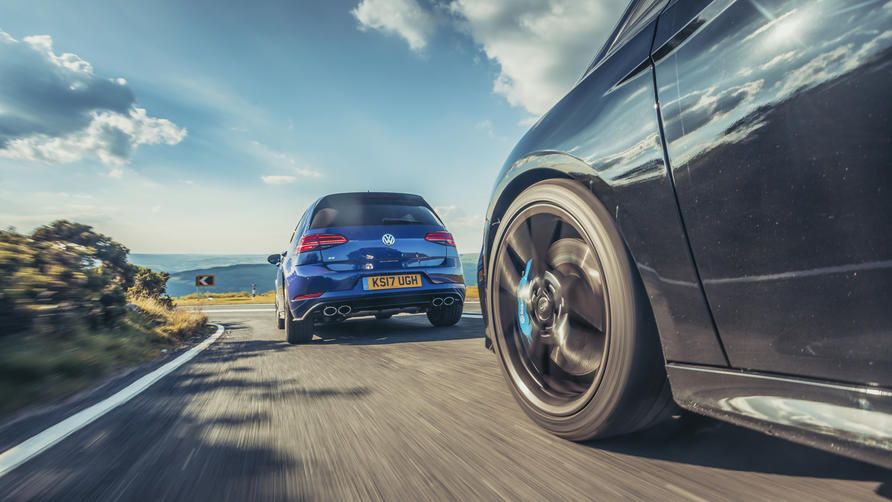
Where does this leave the Focus RS? Surprisingly, in quite a strong position. Like the Civic, it’s from the wilder, less constrained end of the hot-hatch spectrum, but unlike the Civic it’s not a steely-eyed professional. It’s garrulous, it’s big-hearted, it’s a right laugh. It’s a pantomime performer, the exhaust ratta-tat-tats, the 4WD system tries to pretend it’s RWD, it always gives its all and even if you try to be analytical, the damn thing nudges you in the ribs, winks and reminds you that you’re having a great time. And you are.
You could get sniffy about the Focus. After all, it doesn’t have the purity of the Civic. But get sniffy about hot hatches and you’re missing the point. Get sniffy and you end up with the Golf R. That’s the Tate Modern of hot hatches: there’s an edginess there somewhere, but it’s all rather culturally sophisticated.
But eventually the Type R’s message gets through, its ruthless professionalism revealing weaknesses in the Focus. You sit too high. The steering feels artificially sharp. And the ride is just too unsettled. It’s not comfortable on motorways, let alone B-roads. The body is buffeted by the road surface, so you jiggle around high up in the cockpit, wishing it would just relax and sink into its spring travel.
So we come back to the Civic. And I bet half of you reading this don’t want to have anything to do with it. You want the Golf R because it looks sophisticated, or the Focus because it’s a macho fast Ford. The Civic is a rally rep. Granted the addenda are more cohesively attached than last time, but put it this way – its visuals don’t span the breadth that its dynamic ability does.

And then I drive it one more time across the Brecon Beacons, and I don’t care about any of that because it’s Just So Special. It moves expensively, the bite and tenacity of the front end is mind-boggling, and the rear sends detectable signals and information – it’s not a lift-off hero, but it’s an active participant. You’ll learn from the Type R.
Never tried left-foot braking before? Get a Civic and you’ll want to, just to see if you can build up power against the brake through corners to maximise traction and keep the turbo bubbling away. I’d also turn off the rev-match software, just to challenge myself a bit further.
I take it home and keep it for a couple of days. I relish the huge boot, a driving environment that’s so much clearer than it used to be, the turning circle, the fact it has a rear wiper now, I marvel at the refinement, for God’s sake. Hadn’t expected any of that. It’s a compelling hot hatch and the winner of this test.
The playful, wayward, up-fer-it Focus is second, and then you can have it either way. Personally I think a DCC-equipped three-door manual Golf R would be an awesome device, but I can’t argue with the fact that on the day, the Leon was a livelier, more amusing car.
But just look at the diversity we have in this class now. Isn’t that the best thing about it all? That each marque goes about the hot-hatch conundrum in an entirely different way and comes up with a genuinely brilliant car? I’d be amazed if someone considering the Golf R was also looking at the Type R. But I hope they are, because that Civic is something else.
Trending this week
- Long Term Review
Life with a 500bhp BMW 550e: do you really need an M5?





